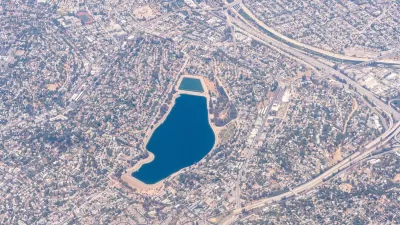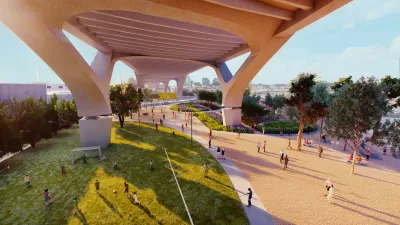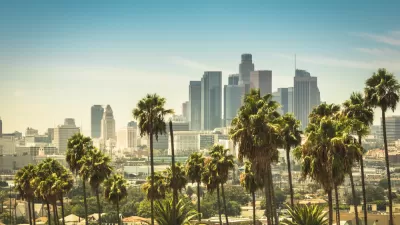Christopher Hawthorne completes his second installment in an ongoing series examining the transformation of Los Angeles through the lens of its famous boulevards. This entry focuses on the most famous street in the city - Sunset Boulevard.
Traversing Sunset "in the opposite direction", from west to east, Hawthorne explores the street's transformation as it points the way towards L.A.'s multimodal future. As he makes his way from the beach, and Sunset's famous gated enclaves on the west side of the city, towards the bustling nightlife of Hollywood and the eclectic street life of Boyle Heights, Hawthorne notes how the street provides (or fails to provide) a pedestrian-friendly environment.
Hawthorne describes the replacement of movie studios and entertainment-focused businesses with "hardier strains of L.A. architecture" along Sunset in Hollywood, as the city "tries to redefine itself for a denser and less car-dependent future." He also notes the newly opened Sunset Triangle Plaza, in Silver Lake, "A more nimble example of L.A.'s rekindled interest in street design and
the public sphere."
But what Hawthorne finds along Sunset (renamed Cesar E. Chavez Avenue) in the east L.A. neighborhood of Boyle Heights makes him most excited. "Shaded by huge ficus trees and crowded with pedestrians, the stretch of
Cesar Chavez just east of the 5 Freeway upends a few persistent
stereotypes about Los Angeles: that nobody walks, that everybody lives
in a single-family house, works in the movie business and spends most of
his time cocooned in an air-conditioned car, shouting Ari Gold-style
into his cellphone earpieces."
"Much of the street's success can be credited to neglect from the larger
city," writes Hawthorne, "as investment in the post-war era went elsewhere. But Cesar Chavez
Avenue hasn't just survived: It has emerged as a model for other
neighborhoods eager to make their major thoroughfares friendlier to
pedestrians, cyclists and local business. It has all the urban-design
amenities the average L.A. boulevard is desperately missing."
FULL STORY: For Sunset, a new dawn

Alabama: Trump Terminates Settlements for Black Communities Harmed By Raw Sewage
Trump deemed the landmark civil rights agreement “illegal DEI and environmental justice policy.”

Study: Maui’s Plan to Convert Vacation Rentals to Long-Term Housing Could Cause Nearly $1 Billion Economic Loss
The plan would reduce visitor accommodation by 25% resulting in 1,900 jobs lost.

Planetizen Federal Action Tracker
A weekly monitor of how Trump’s orders and actions are impacting planners and planning in America.

Restoring Northern India’s Himalayan ‘Water Temples’
Thousands of centuries-old buildings protect the region’s natural springs and serve as community wells and gathering places.

Milwaukee to Double Bike Share Stations
Bublr Bikes, one of the nation’s most successful, will add 500 new e-bikes to its system.

DC Extends Application Window for Outdoor Dining Permits
District restaurants will have until the end of November to apply, but businesses with permits in rush hour parking lanes must end operations on July 31.
Urban Design for Planners 1: Software Tools
This six-course series explores essential urban design concepts using open source software and equips planners with the tools they need to participate fully in the urban design process.
Planning for Universal Design
Learn the tools for implementing Universal Design in planning regulations.
Caltrans
Smith Gee Studio
Institute for Housing and Urban Development Studies (IHS)
City of Grandview
Harvard GSD Executive Education
Toledo-Lucas County Plan Commissions
Salt Lake City
NYU Wagner Graduate School of Public Service





























